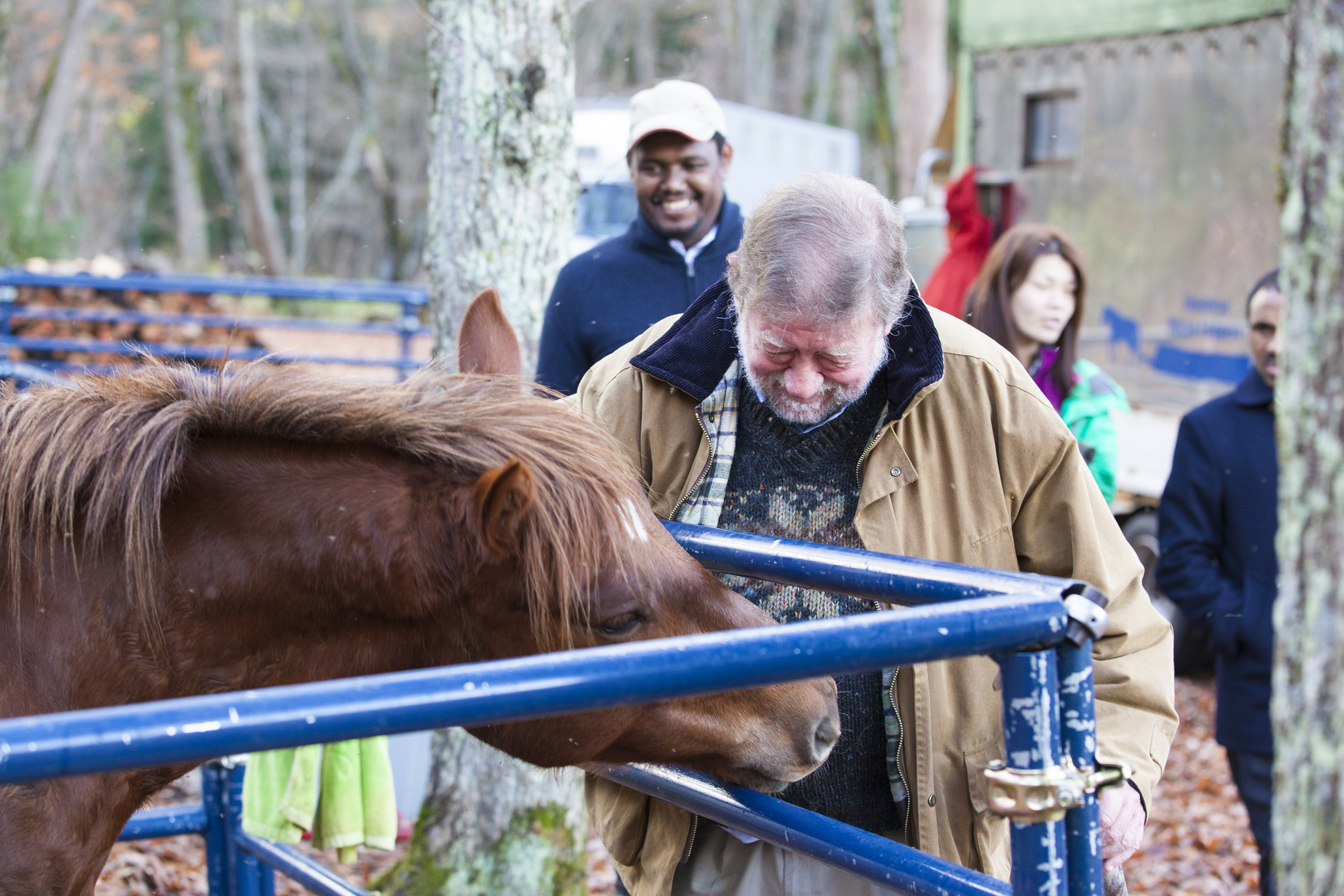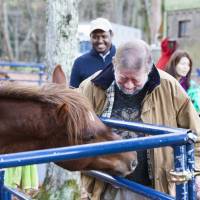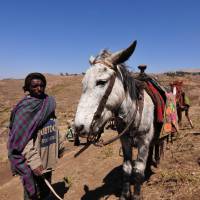Over the past three years, the C.W. Nicol Afan Woodland Trust has been bringing down people and horses from Tono and Morioka in Iwate Prefecture to help us take out trees we've been thinning from our woods here in northern Nagano Prefecture — and lately, too, from the adjoining national forest we've been asked to oversee.
This logging gives the remaining trees more space and light, and so fosters improved biodiversity — while, unlike heavy machinery, horses don't compact the earth and damage the woods.
For me, working with horses also brought back the intense feelings I knew as a boy in Wales and then again as the founding warden of the Simien Mountain National Park in Ethiopia.
When I was there in the late 1960s, the Simien had no roads for motorized vehicles, and all goods and supplies were carried by horses, mules, donkeys or people.
The Simien horses were mainly Abyssinian, one of the world's oldest known breeds. Small and tough, these animals are able to endure the high altitudes and hot daytime sun, as well as the near-freezing nights.
Back then, while I was creating the park where none had existed before, we had 20 horses and mules, and for big jobs we'd hire more. Two of the horses I bought and paid for myself. They were as special to me as the German shepherd dog Mogus — my companion, my guard at base camp and my right-hand canine on anti-poacher patrols.
In Wales when I was a boy, horses were still used in the towns to haul carts loaded with milk churns, sacks of coal and barrels of beer, while in the countryside their power was indispensable for all kinds of work in the fields and farmyards.
I regularly rode the two-wheeled cart that collected milk from the mountain farms and which took me up to my Auntie Peg's cottage on holidays. Riding the cart, standing beside a gruff old man called Griffiths who collected the milk, I felt like a Celtic warrior going into battle against invading Romans. In truth, though, the only tough thing about those wonderful trips was to trying not to laugh each time the old mare in front lifted her tail and farted.
"You'd be doing that too if you ate grass all the time," Griffiths said.
During my first sojourn in Japan, from 1962 to '65, horses were still common in the countryside, used for forestry and agriculture. However, by the time I came to live here in Nagano in 1980, the only ones left were owned by the few riding clubs that existed then.
Recently, after consulting with staff and friends, I decided that we would bring horses back to the woods and to our countryside culture and scenery.
If we ever have to extract big, heavy logs, we can always call on 1,000-kg class Percheron horses from Iwate — but what we need on a regular basis are small horses capable of hauling logs of around 30-cm diameter as well as carts and sleds. We could also use them to pack supplies and camping equipment into the mountains.
In addition, because we have a lot of visitors, including lots of children, we need horses that can easily adjust to the presence of humans other than their handlers and grooms.
Our leading horse experts, Ken Hachimaru and his wife, Yukiko, have 20 horses up in Iwate, which they use for logging, farming, hauling carts, horse therapy and riding. Through them, we have now acquired two 6-year-old geldings from Hokkaido. Both these fine specimens (whose full names, including the honorific suffix, are Yuki-maru and Chacha-maru) are about 500 kg, which is just the right size for our use.
Yuki is a Hokkaido Dosanko, the only one of Japan's eight indigenous breeds that is not endangered. Some say Korean fishermen took the first Dosankos to Hokkaido in the 15th century, and that they were a mix of breeds from Mongolia and the plateaus of Central Asia. Others claim they derived from horses taken to Hokkaido from the Tohoku region of northeastern Honshu during the late Edo Period (1603-1868) and abandoned there.
Whatever, the Dosanko — whose big heads certainly remind me of horses I rode while making a television documentary in Inner Mongolia — are hardy, used to cold and snow, and generally of a calm and pleasant temperament. That's just right for us.
Meanwhile, Chacha is three-quarters Dosanko and one-quarter Quarter Horse. The Quarter Horse is a famous American breed first raised in 17th-century colonial Virginia from a cross between Thoroughbreds from England and American Indian horses. The latter were, in turn, derived from animals brought over by Spanish Conquistadors in the early 16th century, most of which derived from Iberian, Barb and Arab stock.
The Quarter Horse got its name for its explosive speed over a quarter-mile (0.4-km) course. This tough little horse could work all week and race on weekends.
As people and their horses migrated west across North America, the Quarter Horse was bred with tough tribal horses, and eventually became the favored mount of cowboys. It could survive for a while on poor fodder, be ridden all day, was careful but unafraid of cattle — and could turn, twist and sprint, allowing the cowboys to marshal herds often numbering thousands of head.
Last month, our friends from Iwate, Ken Hachimaru and Takashi Iwama, visited again — this time to haul out logs from our woods. They brought the indomitable Percheron aptly named Samurai King to do the heavy work, with Yuki and Chacha coming along for the ride as it were — but actually to get their first experience of the woods.
Both young horses, in three days, were able to haul out enough larch logs to make new furniture for our Horse Lodge. The furniture will be created by Okamura Co., which has helped us over the past three years, both as a sponsor and creator of items made from horse-logged timber.
As luck would have it, that visit coincided with one by Ethiopian Ambassador Markos Rike, who came to talk to me about the future of the Simien Mountain National Park. Ambassador Rike, like so many Ethiopians, grew up with horses, so we had lively conversations about equines and their place in human history and cultural development.
After those visits, a Shinto groundbreaking ceremony for the trust's new Horse Lodge was performed on Nov. 24 — so by the middle of 2016, the lodge and stable should be completed and Yuki and Chacha will then come to live in their new home and work with us in the woods.
This will be a new chapter in the ongoing dream that is our woodland trust — and it will be nice if some of you treasured readers can join in and enjoy it all with us.
To contact the C.W. Nicol Afan Woodland Trust, email [email protected].





















With your current subscription plan you can comment on stories. However, before writing your first comment, please create a display name in the Profile section of your subscriber account page.